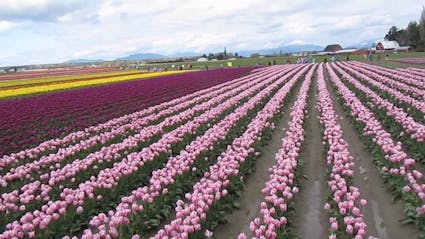Skagit Horticulture

The Company: About Skagit Horticulture
Skagit Horticulture is a successful wholesale grower of plants and flowers. From its greenhouses, container yards, and open field production, the company brings color and life to over 600 acres.
The rich, fertile soil of the Skagit Valley in northwestern Washington grows 90 percent of the nation’s spinach seed and half its beet and cabbage seeds. But the valley is best known for its flowers. Beginning in March and continuing through May, the entire valley floor is a carpet of blooms, backed by dramatic views of Mount Baker and the North Cascades. Skagit Horticulture is a successful wholesale grower of plants and flowers in the heart of the valley. From its greenhouses, container yards, and open field production, the company brings color and life to over 600 acres.
The Situation: Company Merger
Sowing Seeds of Success
In 2017, Skagit Horticulture merged with another grower to form a much larger operation with five locations across Washington and California. Shortly after the merger, the company began shopping for a new ERP application.
“Each company had been using separate systems, but neither had the breadth we needed to unite the diverse aspects of our business,” recalls Cathi Barta, CFO of Skagit Horticulture. “One application was specific to the grower industry and the other was pure accounting. We needed an ERP application with broad industry capabilities combined with manufacturing, inventory control, and financial management.”
The Solution: Sage X3 ERP
“Comparing the two finalists, Sage X3 was the hands-down winner,” notes Jeremy. “At our core, we’re a manufacturing operation, and Sage X3 has by far the strongest manufacturing capabilities.”
Cathi adds, “We could see that Sage X3 could support our entire operational workflows, plus provide the financial backbone every fiscally smart company needs.”
The Sage X3 technology platform impressed the company. “It’s highly configurable, meaning we can adapt it to our workflow without hiring programmers to customize it,” explains Jeremy. “We also appreciate how we can easily manage application security and how we can tailor the user experience by role or even by an individual user.”
The Forecast is Clear
The growing season in the Pacific Northwest is short, so growers must plan – and plant – wisely. “We work within a 20-week growing period,” says Jeremy. “If we don’t have product ready to sell during that time, it’s game over.”
Demand planning takes on increased importance in an industry growing live goods with a limited shelf life. It is further complicated by the fact that many of the raw materials must be procured up to two years in advance. In the past, the company struggled with demand planning, planting primarily on speculation grounded in industry experience.
“Our customers don’t always plan ahead, so we have to,” says Cathi. “With Sage X3, we can bring data into the planning process. We’re able to incorporate customer estimates, prior years’ sales, and our own predictive analytics into our demand planning for better accuracy and more confidence.”
“Improved sales forecasting, combined with our ability to monitor what our customers have on their shelves, allows us to maximize revenues and optimize deliveries during our short selling season,” says Jeremy.
The Results: Sage X3 ERP Implementation Benefits
Seed to Sale Visibility
Using Sage X3, Skagit Horticulture has near real-time visibility into its entire plant inventory. Employees use tablet computers and scanners in the field to record plant heights, select products for shipping, and record merchandise as they load plants onto trucks for delivery.
“In this industry, if you lose that visibility, you’re breeding chaos,” Jeremy says. “Our sales teams depend on accurate information. Without it, we risk overpromising, or could be left with excess stock that goes to waste.”
Cathi agrees. “One of the biggest wins with Sage X3 is knowing what we have on hand and when it’s ready to go. It gives us confidence in our decisions, allowing us to better serve our customers and maximize revenues.”
Room to Grow
Recently, the company launched an eCommerce site for its business division that serves retail nurseries and garden stores. The site integrates with Sage X3, ensuring customers see accurate product availability and pricing information.
“Plus, since the orders flow directly into Sage X3, there’s no data entry involved so we’re able to process more orders with fewer employees,” notes Cathi.
Skagit Horticulture continues to grow and expand its operations, and with Sage X3, the company knows it has a strong platform to support that growth. “With Sage X3, we could triple in size without outstripping its capabilities,” concludes Jeremy.
Additional Sage X3 ERP Case Studies
Below, you can explore additional ERP case studies, showcasing companies that have reaped significant benefits from successful ERP implementations of Sage X3 ERP.
Additional Agriculture Industry Case Studies
Explore additional case studies below, featuring companies in the Agriculture Industry. Also, see our comprehensive side-by-side comparison of all ERP systems for the Agriculture industry.
Still seeking industry-specific information? Compare the top ERP software for the Agriculture Industry to find the product that best meets your company's needs and budget.
